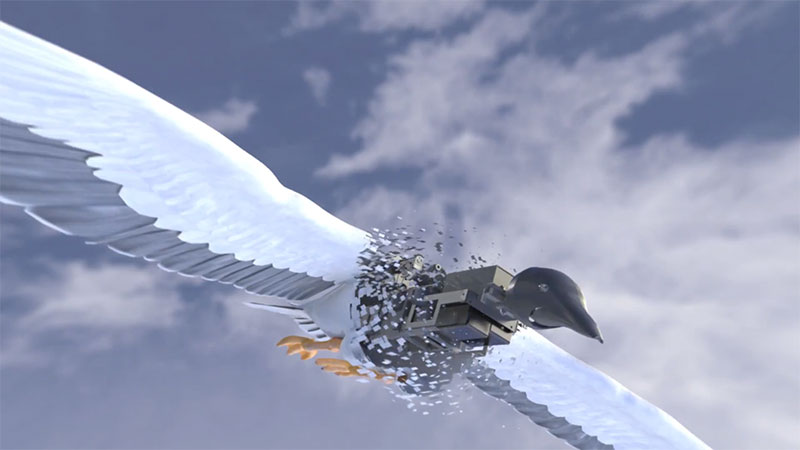PRESS
Flygildi Emerges from Stealth at DroneX 2023
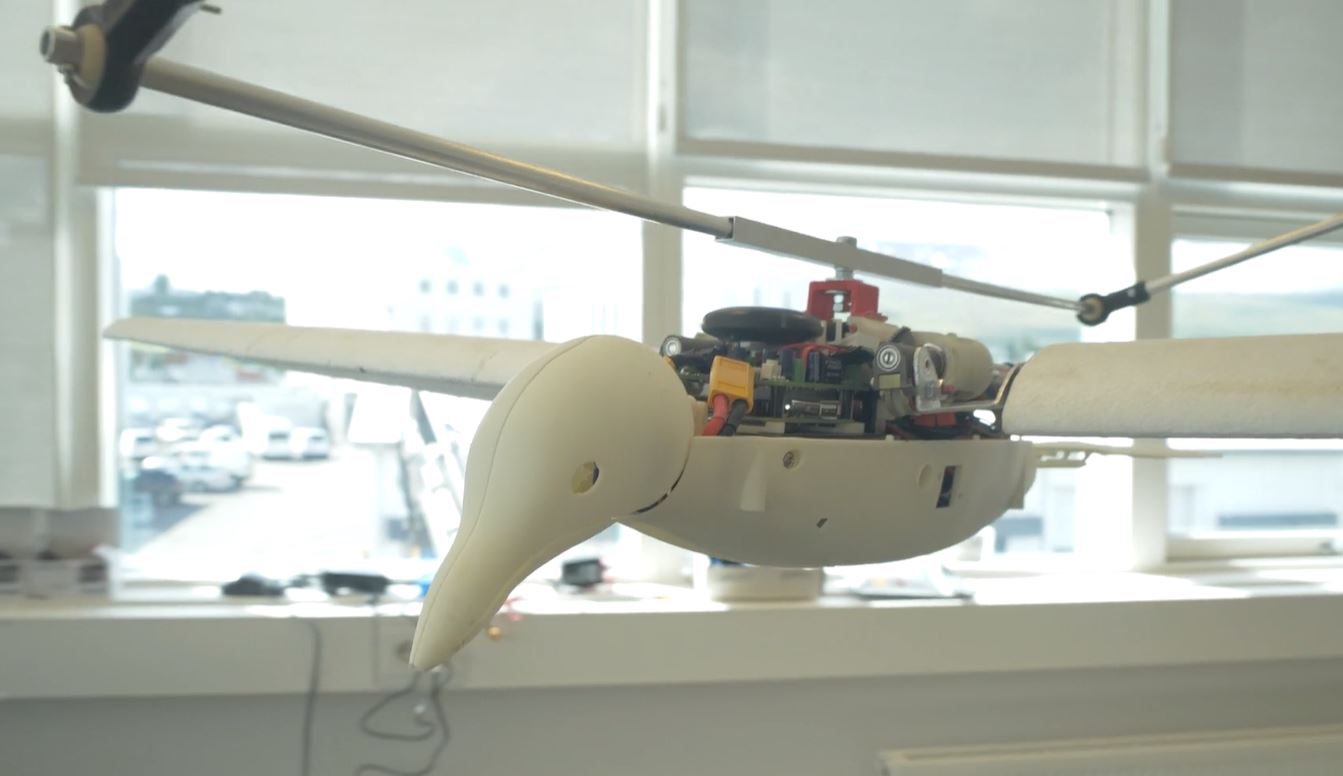
26 September, 2023 – DroneX Expo, London, Stand E-76 – Flygildi (Reykjavík, Iceland) – an innovative startup developing the world’s first UAV to look and fly like a bird – today emerged from stealth at the acclaimed DroneX Expo with a unique new drone that looks and flies just like a bird.
Designed for a range of civilian and military applications, Flygildi´s Silent Flyer surveillance drone aims to fill the gap left by conventional UAVs by using wings instead of rotors for propulsion, making it stealthy and quiet as it flies overhead just like a bird.
Demonstrating the Silent Flyer drone publicly for the first time at DroneX, Flygildi’s design uses morphable, flapping wings for both propulsion and maneuvering – rendering this bio-inspired robotic bird a disruptive new offering amongst commercially-available drone solutions.
Inspired by nature, the Silent Flyer is a unique and patent-protected design that can be designed to mimic a wide range of avian species, with the first iteration of the prototype designed to mimic a seagull in shape and incorporating AI-backed flying patterns.
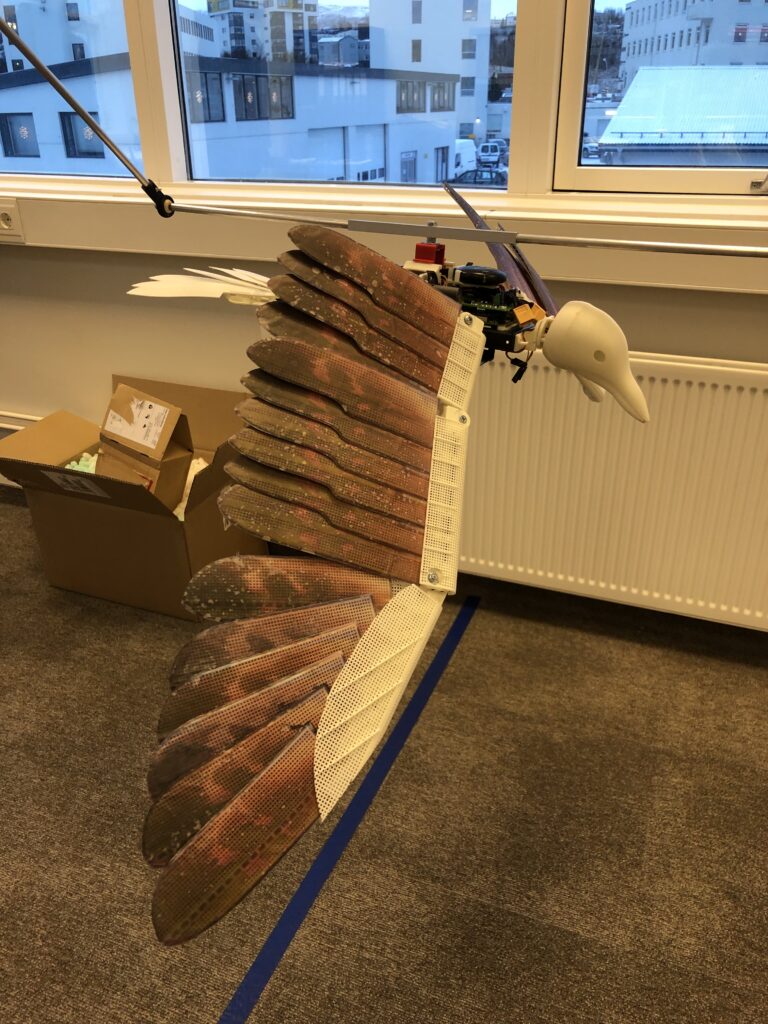
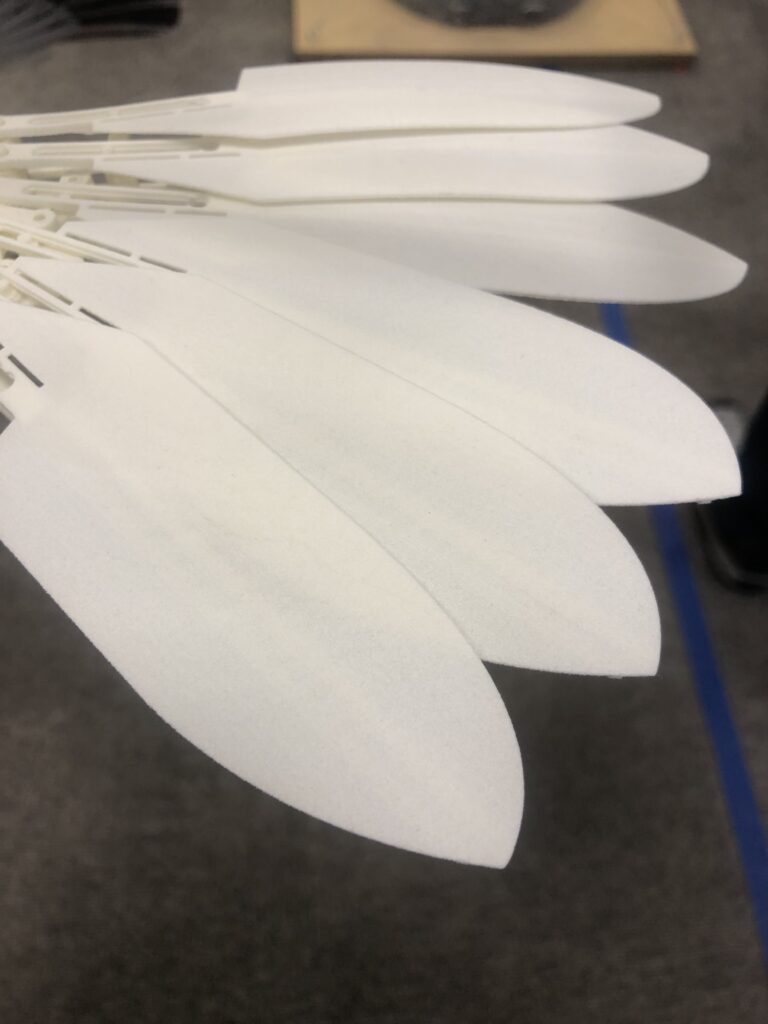
Initially created for defense applications and covert enemy troop monitoring due to its bird-like visual appearance and movement characteristics, the Silent Flyer is also ideally-suited for civilian security and surveillance scenarios in which covert operation is essential or beneficial. Such scenarios include monitoring crimes such as human trafficking, drug trafficking, environmental crimes, animal poaching, and other types of criminal activities that tend to evade noticeable observation.
Silent Flyer can be a particularly essential tool in border monitoring and migration management, as well as in fishing vessel surveillance, helping to detect illegal fishing, fish dumping, maritime pollution, or performing emissions monitoring. Whenever the presence of a noticeable observer would prevent or handicap successful crime fighting, the Silent Flyer can be the tool of choice.
Flygildi has partnered with Purdue University to test the prototype Silent Flyer and is working closely with a range of other partners to bring even more cutting-edge tech to the UAV, including fellow Icelandic startup Nanom <www.nnom.com>. Flygildi are exploring the integration of Nano-enhanced Structural Energy Storage from Nanom, which turns the carbon fiber body parts of the Silent Flyer into a supplementary battery. This can positively enhance both the design and energy storage for the UAV, as the wing armature can now actually store energy without the need for additional Lithium Ion batteries.
The Silent Flyer has always been envisioned since Day 1 of its first sketches to be a defense-oriented UAV, never designed to carry offensive payloads, to be used by aggressor nations in a conflict or in any form of INTERPOL-defined criminal activities. As such, the vetting process to purchase a Silent Flyer will be both extensive and unyielding.
Governments of NATO Nations are welcomed, as are allies of the Alliance. Countries under illegal attack by aggressor nation-states will also be considered acceptable customers. Countries planning to use Silent Flyer must adhere to these guidelines as part of the contractual agreement to purchase the UAV.
Details on the Silent Flyer may be found at www.silentflyer.tech – pricing and availability have not yet been released by Flygildi. Videos and other assets may also be found at the company website.

“Flygildi is very excited to at last publicly showcase the years of design and iterative development that have gone into our prototype - we are looking forward to hearing from our peers in the UAV industry segment about their opinions concerning the unique design and capabilities of the Silent Flyer. We are hoping to gain both partners and feedback as we finalize the design of Silent Flyer and take it into manufacturing for a range of civilian and military applications where only our solution is uniquely applicable.”
Björg Ormslev Ásgeirsdóttir (CEO)
About Flygildi
Flygildi ehf is a Reykjavík, Iceland-based startup that is developing the Silent Flyer – the world’s first intelligence-gathering, bio-inspired Unmanned Aerial Vehicle (UAV) that looks and flies like a bird. Protected by worldwide patents, Silent Flyer is unique amongst airborne intelligence tools and is designed for a myriad of defense, law enforcement and border protection applications. The Silent Flyer will actually fly by flapping its wings, effectively impersonating a bird to all observers. With room for additional small payloads in addition to recording devices and cameras, the Silent Flyer is a cost-effective tool designed to help preserve lives in peacetime and warfare alike. Learn more at www.silentflyer.tech.
Flygildi and Silent Flyer are trademarks of Flygildi ehf. All other trademarks and registered trademarks
previously cited are hereby recognized as the property of their respective owners.
Interested media should contact Flygildi PR Counsel Jonathan Hirshon at jh@horizonpr.com
FAQ
What is Flygildi designing?
Flygildi is developing and commercializing the Silent Flyer, a novel and unique Unmanned Aerial System (UAS) that resembles a natural bird in its appearance and the way it flies. The use of morphable, flapping wings for propulsion and maneuvering and the ability to customize it for different use cases render this bio-inspired robotic bird a disruptive new offering amongst commercially available drone solutions.
What is unique about the Silent Flyer UAV compared to others currently on the market?
Inspired by nature, the Silent Flyer is a unique and patent-protected robotic bird system that uses adaptable flapping wings to generate lift and propulsion and that takes on the appearance of a wide range of avian species.
Are there any patents protecting the UAV?
The concept of the Silent Flyer was invented by Flygildi ehf. The first 3 patent applications have been granted by EPO (Unitary Patent, Poland and UK) and 3 pending patent applications in three major markets – USA, China and South Korea. All of the existing, granted patents are the sole property of Flygildi ehf.
How much money has the company raised to date?
We have raised USD 2.200.000 (300M ISK) from a range of Icelandic angels, VCs and government programs.
How many employees are in the company?
The team at Flygildi is composed of highly-educated, experienced professionals who have previously developed, commercialized and brought to market a range of hardware tech and software solutions. Thus, the necessary skills, knowledge, and capacity to execute this project on time and within budget are already present in our small but exceptionally experienced team. Currently there are four full time employees working for the company, together with a joint team at Purdue University, who are assisting with tests of our prototypes.
What are the primary materials in the UAV design?
Plastic and aluminum, with some carbon fiber struts in the wing armature and also used in our revolutionary carbon fiber-based supplementary battery – which is actually the wing armature itself thanks to a unique license from Icelandic battery startup Nanom.
Is this strictly a military UAV or does it have civilian applications?
Due to its bird-like visual appearance and movement characteristics, the Silent Flyer is also ideally-suited for civilian security and surveillance scenarios in which covert operation is essential or beneficial. Such scenarios include monitoring crimes such as human trafficking, drug trafficking, environmental crimes, animal poaching, and other types of criminal activities that tend to evade noticeable observation. The system can be a particularly essential tool in border monitoring and migration management, as well as in fishing vessel surveillance, helping to detect illegal fishing, fish dumping, maritime pollution, or performing emissions monitoring. Whenever the presence of a noticeable observer would prevent or handicap successful crime fighting, the Silent Flyer can be the tool of choice.
What is the expected price point of the Silent Flyer?
The pricing strategy is not completed due to the UAV still being in the prototype phase. It will also depend on the choice of options (from an empty bird to a bird equipped with different sensors and cameras).
Is the name of the company Flygildi or Silent Flyer?
Flygildi is an innovative company, founded in Iceland with the purpose of developing a ground-breaking drone solution for covert and silent operations. It was founded by Mr. Hjalti Hardarson and Dr. Leifur Thor Leifsson, who have more than 20 years’ extensive international experience in the development and commercialization of autonomous unmanned vehicles, both for aerial and underwater usage. Flygildi is developing a first-of-its-kind UAV, named the Silent Flyer. A UAV of unrivaled first choice amongst global users within both the security and surveillance services.
What is the estimated range on a full charge for the UAV?
It will be determined by which batteries will be chosen when the development is further advanced. Currently, we are still in testing and ongoing development. There is also exciting progress in this market that is worth investigating further as the UAV design is finalized.
What will the expected pricing be per drone, if purchased individually?
The pricing strategy is not completed. It will also depend on the choice of options (from an empty bird to a bird with different sensors and cameras).
How does this compare to the costs of the existing drones on the market?
The pricing strategy is not completed.
Will Flygildi sell this UAV to any purchaser with the money to buy it?
The Silent Flyer has always been envisioned since Day 1 of its first sketches to be a defense-oriented UAV, never designed to carry offensive payloads or to be used for aggressor nations in a conflict or used in any form of INTERPOL-defined criminal activities. As such, the vetting process to purchase a Silent Flyer will be extensive and unyielding. Governments of NATO Nations are welcomed, as are allies of the Alliance. Countries under illegal attack by aggressor nation-states will also be considered acceptable customers. Countries planning to use Silent Flyer must adhere to these guidelines as part of the contractual agreement to purchase the UAV.
What are the primary use cases for the Silent Flyer?
Flygildi´s Silent Flyer drone aims to fill the gap left by conventional drones by using wings instead of rotors for propulsion, making it stealthy and quiet as it flies overhead like a bird. Being silent, the drone has multiple applications for covert and surveillance purposes, as well as wildlife photography and research. Following are three use cases for the Silent Flyer.
Security and surveillance.
The Silent Flyer can be of great use as a crime fighting tool. At events where large groups of people gather, such as concerts, sporting events in parks and open fields it can be vital to have a device that can monitor the people and the surrounding area. The Silent Flyer can detect potential hazards situations such as fire, upcoming panic at events where conventional drone noise would disturb the participants and audience, such as classical open-air concerts. Also, fighting environmental crime, animal poaching, drug traffic, and other types of crimes requires the provision of visual evidence to court. In many cases, this is very difficult to obtain due to the combination of the inaccessibility of the crime scene and the presence of observers who may detect police officers, border patrols, coastguards, forest guards, park rangers, rural guards, and other critical security bodies, preventing them from taking video image of a crime that is being committed. Due to its low noise emissions and its capacity to mimic the appearance and flight of real bird species, the Silent Flyer can fly over the crime scene, passing unnoticed to observers and criminals on the ground, law enforcement bodies could thus use the Silent Flyer as an eyewitness tool to take video images that would be used as proof-positive evidence of a crime.
Pest bird population control.
Bird strikes represent a continuing global danger to the safety of air travel. The aviation industry spends a huge sum of money per year on bird strike damage and delays. Bird activity in airport environments creates a collision hazard for aircraft as 75% to 95% of bird collisions with civil aircraft occur at the airport or close to it, during both take-off and landing. Both large birds and flocks of smaller birds can be very dangerous to planes, either by impacting the windscreen or being sucked into the engines. This not only causes significant damage to the plane and high economic losses because of plane shutdown, but can also create hazardous and unsafe flying conditions if critical damage occurs. Airports could use the Silent Flyer to mimic a falcon or another bird predator to scare away birds that interfere with flight operations.
Farmers.
Beyond the airports, birds can be one of the worst nightmares for farmers resulting in loss in crop and fruit productivity. The problem is especially difficult at large farms, due to the large size of cultivated area. Farm owners could use Silent Flyer imitating natural bird predators to scare away pest birds feeding from the crops. Drones of the multirotor and fixed wing types have been tried as bird deterrent, both at airports and in agriculture, with low levels of efficiency in the medium to long term. Like other more conventional bird-scaring techniques such as lasers, flares, distress calls, loud noises from shotguns, inflatable scarecrows, Radio-Controlled (RC) planes, and dogs patrolling, conventional drones fail because they do not resemble a real natural predator to birds. Birds’ natural instincts are not activated, and sooner or later, they find out these measures present no real threat for them. Farm owners could use Silent Flyer imitating natural bird predators to scare away pest birds feeding from the crops. The Silent Flyer triggers the instinct of other birds because of the combination of silhouette and wing movement as the fear for their natural enemy is imprinted in their DNA.
Fishing boat surveillance.
The Silent Flyer can help improve surveillance of fishing vessels, e.g. for maritime pollution and emissions monitoring, the detection of illegal fishing, anti-drug trafficking, and illegal immigration, as well as search and rescue operations. The European Fisheries Control Agency (EFCA) is already using a quad-copter drone to spy on fishing boats. The quad-copter has the drawback of being easier to spot than a bird-like drone. Potential offenders could thus delay illegal activity if they realize that they are being watched.
Can the Silent Flyer carry any payload?
As it is today, payload is up to 200g.
What is the camera range and type mounted in the drone?
We closely monitor camera development and evaluate them for each situation. There is not one camera that has been chosen over another, as there will always be a possibility of customization.
Can the UAV fly autonomously based on a pre-programmed flight path or must it be operated by a remote user?
Our plan is to have machine-learning supported flight: The aerodynamics of a vehicle with morphing and flapping wings in agile maneuvering introduces a complexity beyond the capacity of conventional control systems. We are developing a sophisticated, real-time software system based on deep reinforcement learning. This system will initially be trained in a controlled environment, such as a wind tunnel, and will gradually be exposed to increasingly challenging conditions. This innovative software system will represent a milestone in the control of complex ornithopter vehicles.
Are there any kinds of new battery technologies in use by the Silent Flyer?
Not currently, but there are ongoing discussions with www.nnom.com to incorporate their revolutionary carbon nanotube-based battery into the wing armature of the UAV, which is already Carbon fiber.
Have any prototypes of the Silent Flyer been built? If yes, does it represent the final expected design?
Yes, we have had several prototypes. However, they do not yet represent the final expected design. In the Summer of 2023, Flygildi started a cooperation project with Purdue University, one of the world’s leading universities in innovation and development and with a strong focus on aeronautics and astronautics. Dr. Leifsson, a professor at the university, leads the project with comprehensive testing of the evolving Silent Flyer model in a wind tunnel as well as in the largest aerospace engineering facility in the US. The test results are used by a joint team of Purdue and Flygildi to improve and optimize the aerodynamic properties of our drone system.
Does the UAV have a built-in radio for real-time data streaming?
There will be in the final product.
Is there a programmable transponder to help recover a downed UAV?
The specifications on technology needed can be customized for each need, and we expect to offer this as an option to customers requiring this feature.
Is there a self-destruct for any recorded data in case the UAV is downed or not given a “fail-safe” code within a certain period of time?
The specifications on technology needed can be customized for each need, and we expect to offer this as an option to customers requiring this feature.
When will the Silent Flyer be available for purchase?
That is very dependent on what partners choose to work with us in the commercialization of the UAV and what they choose to provide in that partnership from a patent, technology and sales/marketing perspective. We expect first commercial shipment within 2 years, with our current partnerships.
Have any military or civilian Agencies seen the demo as of yet? If yes, how was their reaction?
No, the 2023 DroneX Exhibition is our first appearance where we are letting the world know that we exist!
How easy is it to service or repair the UAV in the field?
Flygildi will provide maintenance services, customer support services, and supply spare parts.
What is an sUAS and does the Silent Flyer qualify as one?
A small unmanned aircraft system (sUAS) comprises an unmanned aircraft and the equipment necessary for the safe and efficient operation of that aircraft. The system generally includes a fixed or rotary-wing (tethered or non-tethered) aircraft and a Ground Control Station (GCS). sUAS must be operated in accordance with Federal Aviation Administration (FAA) regulations and statutory requirements. Definitions (see 44 U.S.C. § 44801; 49 U.S.C. § 40101 note; 14 C.F.R. § 107.3 for these and other relevant definitions):
– Small unmanned aircraft means an unmanned aircraft weighing less than 55 pounds on takeoff, including everything that is on board or otherwise attached to the aircraft.
– Small unmanned aircraft system (small UAS) means a small unmanned aircraft and its associated elements (including communication links and the components that control the small unmanned aircraft) that are required for the safe and efficient operation of the small unmanned aircraft in the national airspace system.
– Unmanned aircraft means an aircraft operated without the possibility of direct human intervention from within or on the aircraft.
Note: Previous item 03OE-07-RPVS has been replaced by 03OE-07-ROVL (for land vehicles), 03OE-07-UMVS (for maritime systems), and 03OE-07-SUAS (for aircraft systems). Flygildi will apply for this compliance when the drone has reached the final prototype stage.
Does heavy rain or winds impact the Silent Flyer’s performance in the field?
Yes, it will affect the flying and speed of the bird. This aspect needs to be much more weighed and evaluated.
What is Blue sUAS 2.0 and does Silent Flyer comply with it?
Blue sUAS 2.0 expands the variety and capabilities of DIU vetted drones to provide DoD users compliant, secure sUAS. These systems were selected to include a variety of sizes, capabilities, price points, and flight modalities. Each system has undergone a cyber vulnerability assessment in accordance with the Risk Management Framework, is issued an associated Authority to Operate by DIU, and a FY20 Section 848 NDAA compliance check. This effort also proves out a repeatable administrative onboarding process called “Blue UAS On-Ramp” designed to reduce barriers to entry for commercial sUAS and create a more permissive acquisition process for DoD customers. More systems will be added to the roster soon and Flygildi will apply for this compliance when the drone has reached the final prototype stage.
Does Silent Flyer qualify under NATO Class I UAS guidelines?
The Silent Flyer will have to comply with applicable rules and guidelines in each area it will operate. This work has not yet started.
Does Silent Flyer comply with EDA EMACC requirements?
The Silent Flyer will have to comply with all requirements in each area it will operate. This work has not yet started.
What are the physical dimensions of the Silent Flyer?
Current prototype is the size of a seagull.
Does the Silent Flyer have an actual motor or does it fly just by flapping its wings?
At the present state of development the Silent Flyer uses a motor for flying, however as a final product the Silent Flyer will use only flapping wings for propulsion.
Just how “silent” is the Silent Flyer?
There is no noise from rotors, jet engines or propellers.
How long does it take for the Silent Flyer to become airborne?
That depends on the weight of the configured drone.
Can the bird body and shape be customized for different local bird species?
The Silent Flyer is designed to resemble a seagull-sized bird with respect to both, maneuvering patterns and visual appearance. It can be customized to take on the visual appearance of similar-sized avian species depending on the application scenario. Blending in with its natural counterparts decreases the level of visual intrusiveness, reducing recognisability and detectability.
Does Silent Flyer intend to sell its own UAV’s or license the design?
This option can be discussed with interested parties.
Where will Silent Flyer UAVs be manufactured?
That will depend on which partners work with Flygildi.
Read our brochure
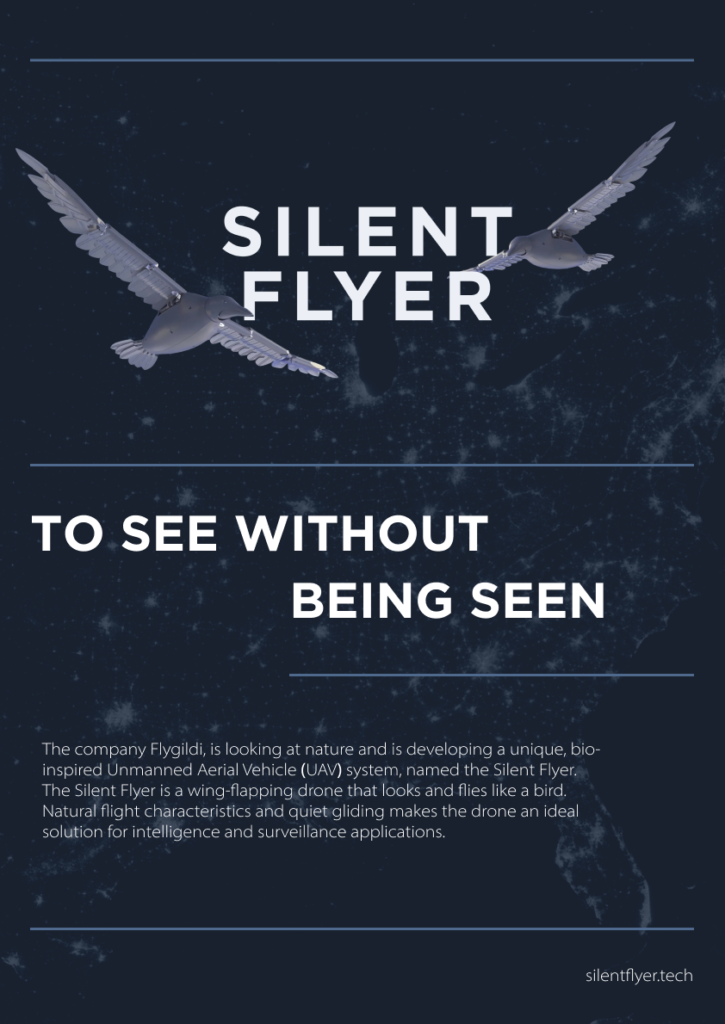
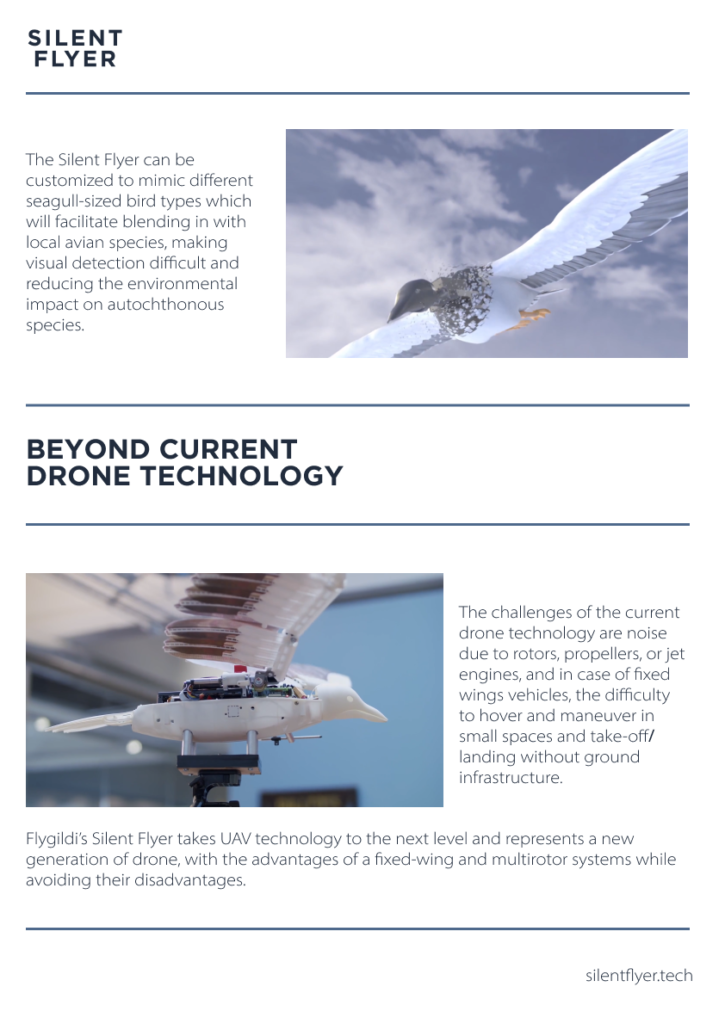
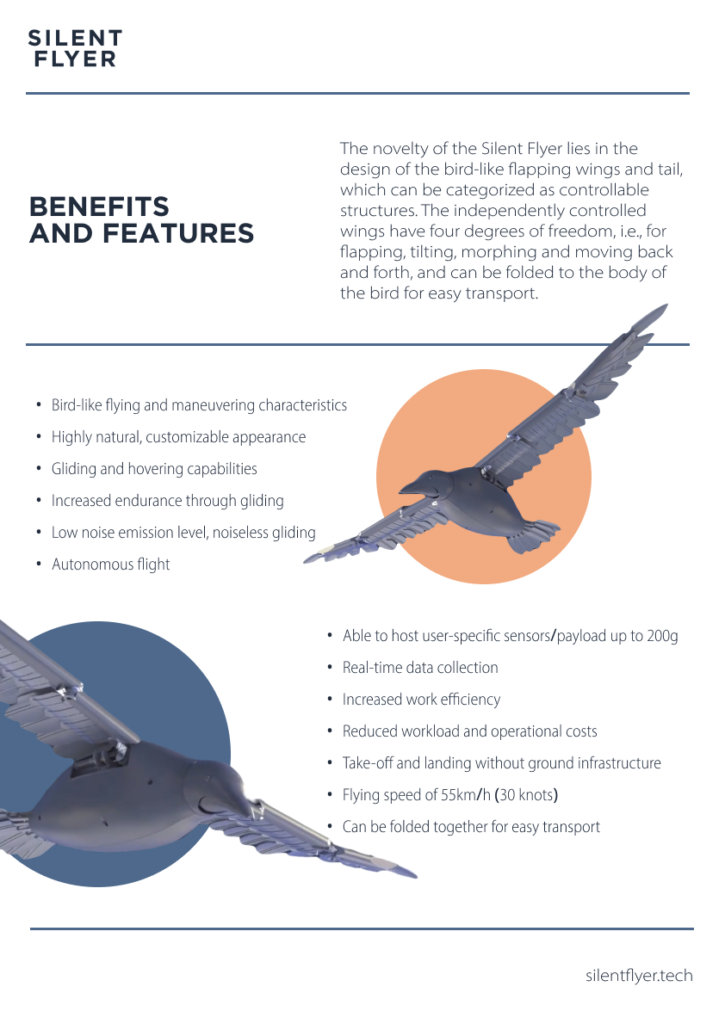





Playlist
General inquiries and media
Email bjorg@silentflyer.tech
Technical inquiries
Email peter@silentflyer.tech
Investor relations
Email helga@silentflyer.tech







